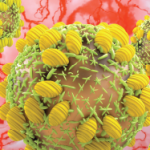
Three presentations at the ACR 2013 State-of-the-Art Clinical Symposium, held April 20–21 in Chicago, focused on vasculitis, with speakers giving the latest information about diagnosis and management of Behҫet’s syndrome, viral infectious arthritis, and central nervous system (CNS) vasculitis.
Behҫet’s syndrome, which is most common in the Mediterranean basin, Korea, and Japan, has distinct features and is “an interesting disease because it doesn’t fit into any category,” said Yusuf Yazici, MD, director of the Seligman Center for Advanced Therapeutics and Behҫet’s Syndrome Center at New York University Hospital for Joint Diseases in New York City.
“The disease burden decreases with the passage of time, and the occurrence of all manifestations seem to decrease in frequency, except for CNS disease and major vascular pathology,” Dr. Yazici said, adding that the most feared complication is pulmonary artery aneurysm.1 For the majority of patients with Behҫet’ssyndrome, the disease will have a gradual onset in the second to third decade of life. Men and women have equal prevalence of the disease, but it tends to be more severe in men, particularly if they get the disease earlier in life.
Symptoms of Behçet’s Syndrome
Most patients present first with oral ulcers, Dr. Yazici said. Minor aphthous ulcers are common and affect the inside of the lips, gingiva, cheeks, and tongue, and they usually heal within 15 days with no scarring. The disease is also marked by genital ulcers, with papules or pustules that ulcerate quickly and have a punched-out appearance, and they can lead to secondary infections. In men, the ulcers are usually on the scrotum; women can be unaware of genital ulcers unless a gynecologic examination is performed. Other skin manifestations include acne-like lesions on the upper back, arms, and buttocks. Acne and arthritis are associated in patients diagnosed with Behҫet’s.
Eye disease, with hypopyon seen in about 20% of cases, is the main focus because Behҫet’s is the leading cause of nontraumatic blindness, after diabetes, in Japan and Israel. Eye disease tends to get milder with time, and major manifestations of symptoms are rare five years after diagnosis. “It is important that eye disease be treated quickly,” Dr. Yazici said.
About 60% of patients will have nodular lesions, with 50% of those erythema nodosum–like lesions and 50% superficial thrombophlebitis. “Clinically, presence of superficial thrombophlebitis is important because it is associated with more severe vascular thrombosis and aneurysms,” he said. There can be nervous system involvement with Behҫet’s, generally either parenchymal disease or dural sinus thrombosis.

